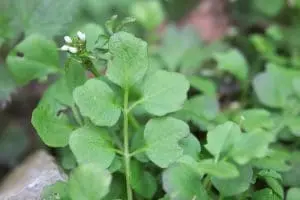A member of the mustard family, bittercress (Cardamine hirsuta) is also known as hairy bittercress, land cress, flick weed, and shot weed. Although it may look lovely with its petite white flowers, it can quickly invade your landscaping if it goes unchecked. Its ability to spread profusely makes it a quick enemy of homeowners and gardeners. However, bittercress is not hated by all–some people find this edible annual tasty as a salad green or cooking ingredient due to its bitter, peppery flavor.
Why Be Bitter About Bittercress?
Common in the damp, recently disturbed soils of gardens and well-watered lawns, moisture-loving bittercress is one of the earliest flowering weeds in springtime. With its tiny white flowers, this fast-wandering weed is sometimes mistaken for a harmless plant. But don’t let it fool you—bittercress is a master of disguise that is small enough to hide among your garden plants or go undetected in your landscaping at first. And those pretty flowers? They turn into problematic pods that explosively spread seeds up to 10 feet away from the parent plant. Just one or two of the plants can quickly start an invasion.
Bittercress Signs and Symptoms
Because bittercress spreads so quickly, immediate identification and eradication is necessary. Here are some characteristics to help you identify it:
- A circular formation of leaves (basal rosette) at the bottom of the plant
- 3” to 9” wiry stems that can reach a height of 12” under the right conditions
- Tiny white flowers, each with four petals, top the stems and grow in clusters
- The flowers turn into a narrow silique, or seed pod, approximately 3/4″ to 1-1/4” long
- Pairs of hairy rounded leaves (you’ll need to look close to see the fine hair)
Bittercress Prevention
Control for this fast-spreading weed must begin early in the season before the flowers turn into seed pods that are like ticking bombs. Fortunately, bittercress has a shallow root system, so you can pull it out from the ground by hand or small hoe. The trick is to get it before the flowers turn to seed pods. If it has already seeded, use a plastic bag to surround it before you pull it to prevent the seeds from spreading.
Keeping your lawn lush and well-maintained is important. Weeds easily find their way in thin or patchy areas of grass, so you can help prevent invasions by keeping your lawn healthy. Use mulch around landscape plants to help prevent the seeds from taking root in the soil.
Severe bittercress infestations require a weed control treatment. If you suspect that bittercress is about to make a mess of your lawn, contact Free Spray Lawn Care at 419-529-5296 for professional assistance in eradicating unwanted weeds.



Comments (0)
Thanks for your comment!
Thanks for your feedback! Your comments have been successfully submitted! Please note, all comments require admin approval prior to display.
Error submitting comment!
There is a problem with your comment, please see below and try again.